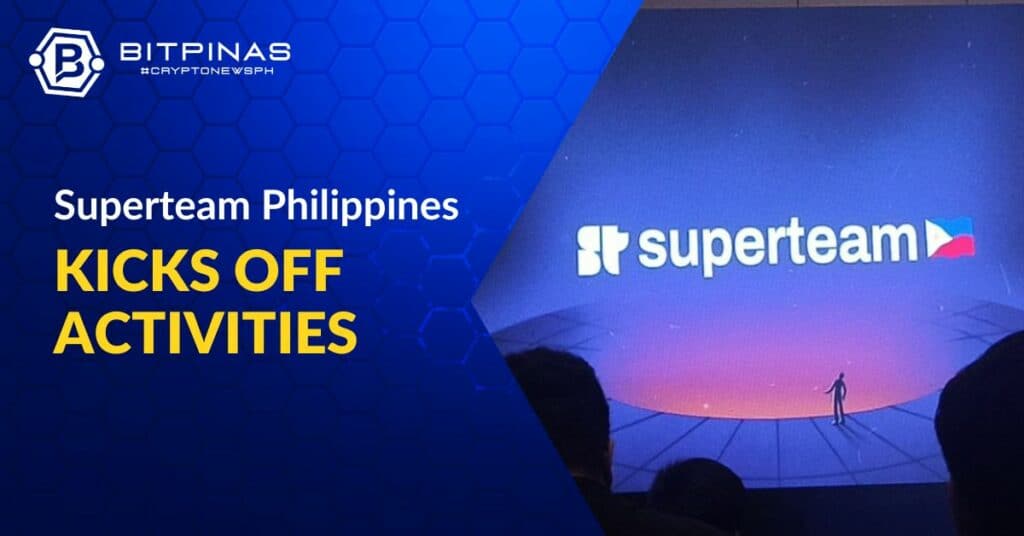The Blokc co -founder, Eli Becislao, reveals how they will incorporate the new builders in the Hiraya Network after the recent Filipino launch of the new local initiative of the Aptos Foundation.
The Blokc is the organization that leads the Hiraya network in the country. In addition, people behind the BOKC are also involved with the SuperTeam Philippines of Solana.
Ensure a fresh talent pool
In an interview with Bitpins, Becislao explained that although they are committed to SuperTeam and the Hiraya Network, the latter adopts a unique approach to incorporate talent in the web space.
- He said that Hiraya Network implements a different approach for hackatones and bootcamps.
- Unlike SuperTeam, where participation was free, Hiraya requires participants to pay a reimbursable amount, ensuring that they have “skin in the game” and are more committed to complete the program.
“For Hyraya, we will take a smaller group of highly motivated developers who are really eager to learn. They have to put a specific amount of money, and after completing the program, they not only recover their money, but they are also rewarded,” he shared.
Becislao added that Hiraya Network is exploring the possibility of returning twice the amount that developers bet or provide an additional incentive, along with equipping them with practical skills for the development of suitables.
- In addition, participants will also obtain a certification to improve their job requests.
- In addition, he emphasized that Hiraya Network guarantees a new group of talents by directing web2 projects and helping them make the transition to web3.
“These are not the same builders we had for SuperTeam. It is a completely new batch of builders and projects. Wait see web2 projects exploring web3, and those will be the builders and projects that we will add to Hiraya,” Becislao concluded.
Different from the approach compared to SuperTeam

Unlike Superteam, Hiraya focuses on introducing fresh talents, promoting sustainable incorporation and boosting the economic impact within the ecosystem.
“Currently, our plans for Hyraya are completely different compared to the plans and activations that were made for SuperTeam. Before, with SuperTeam, we organized several hackatones … From there, Doon Sa Mga Hackathons Na ‘Yon (of those hackatones) and bootcamps, we build a pipe from the top of the fúnel. Filtrate,” he said.
Becislao stressed that Hiraya Network adopts a different approach to associating with technology business incubators (TBI) to incorporate new talents.
Tbis:
- NCR scale: A TBI consortium by Metro Manila
- Idea – Based on Mindanao
- Sili TBI – Located by Bicol
- Umasenso Hub – affiliated with the University of Mindanao
He pointed out that by working with these incubators, Hiraya aims to take advantage of their existing talents groups and identify promising projects that can be moved on to the web3.
Different and metric objectives of success

The key performance indicators (KPI) of Hiraya Network differ from SuperTeam. While Hiraya and SuperTeam are talent incorporation initiatives in the web3 space, they serve different ecosystems and adopt different approaches.
SuperTeam was built to support the solana ecosystem, with a main approach to produce new founders and builders. On the other hand, Hiraya is designed to boost the economic impact by helping Filipino professionals ensure roles within the ecosystem suitable.
“It does not matter if we produce projects or not. Even if we do not have startups or projects that are financed, we can still reach our KPI. If we can display talents that are hired and work within the apotos ecosystem, we are already complying with our metrics,” said Becislao.
He also emphasized that although there may be some overlap between the SuperTeam and Hiraya network, their structure, KPI and focus are fundamentally different.
What is the Hiraya network?

Hiraya Network serves as the Official Talent Center, the builders and the founders of the ecosystem suitable in the Philippines, backed by the Blokc (the Knowledge Center and the Blockchain Leader Organization).
Also read: The Aptos Foundation Finances Hiraya Network to boost Blockchain talent and startups in the Philippines
Complete transcription
SuperTeam Filipinas difference
Reporter bitpins: Last year, Blokc launched a layer of talent for the Solana block chain called SuperTeam, which provides subsidies and encourages builders to build on Solana. Now that the Blokc is launching a new layer of talent (called Hiraya) for the suitable blockchain, How can you ensure that this will not involve the same group of builders who move from a single subsidy to the next?
Eli Becislao, the Blokc: Then, currently, our plans for Hyraya are completely different compared to the plans and activations that were made for SuperTeam.
Before, with SuperTeam, we organize several Hackathons. Then, Mga Ib’t Ibang Hackathons (there were different hackatones). From there, Doon Sa Mga Hackathons Na ‘Yon (of those hackathons) and bootcamps, we build a first -class pipe. Then, of that pipe, the projects that became part of SuperTeam, those who received subsidies, won hackones, etc., leaked.
For Hiraya Network and Aptos, it is a different approach. What we are doing at this time is to form close links with technology business incubators (TBI). We are currently working with Scale NCR, a TBI consortium in Metro Manila. We are also collaborating with other TBI, such as:
- Idea in Mindanao
- Sili Tbi by bicol
- HUB MAKENSE OF THE UNIVERSITY OF MINDANAO
The idea is to take advantage of the existing cohorts of these TBI and identify projects that could join or integrate into web3.
Different kpi for Hyraya Network
The reason we are adopting this approach is because the KPI for Hyraya is different from the kpi for SuperTeam.
- SuperTeam KPI: Producers, builders and founders.
- Hiraya Kpi: economic impact.
It doesn’t matter if we produce projects or not. Even if we don’t have startups or projects that are financed, we can still reach our KPI. If we are able to implement talents that are hired and work within the suitable ecosystem, we are already complying with our metrics.
If you compare this with SuperTeam, the key metrics were the number of projects that are based on Solana and the number of developers that are developed in Solana. That is what we trace for SuperTeam.
For Hyraya, it’s different. We can reach our metrics simply causing Filipinos talents to work on ecosystem projects suitable. It doesn’t matter what project, provided they are working within the suitable ecosystem, we reach the metrics.
How do we ensure that it is not the same group of builders?
To ensure that it is not the same group of builders who received subsidies from the SuperTeam to Hyraya transition, we have implemented a different approach for hackatones and bootcamps.
Before, in SuperTeam, our bootcamps were free. But for Hyraya, participants must spend a specific amount, which will be returned after they finish the program.
In this way, they have skin in the game. In the past, we would get many participants, but the problem was that many of them did not finish the program. For example, if we start with 50 participants, only about 20 would end.
Now, for Hyraya, we will take a smaller group of highly motivated developers who are really eager to learn. They have to put a specific amount of money, and after completing the program, they not only recover their money, but they are also rewarded.
We are considering duplicating the amount they bet or giving them an additional reward, apart from equipping them with difficult skills that allow them to develop in apt. They will also receive a certification they can use when requesting work.
Focus on Web3 Web3 Projects
Another way in which we ensure that it is not the same group of builders is to go to web2 projects that can be joined to web3. We are looking for existing web2 projects and present them to the Web3 space.
These are not the same builders we had for SuperTeam. It is a completely new batch of builders and projects. Wait see web2 projects exploring web3, and those will be the builders and projects that we will add to Hyraya.
Different objectives, different kpi
It is not conflictive because the KPI, the approach and the objectives are different.
SuperTeam was focused on the founder, focused on the production of founders and builders. While Hiraya is a talent, builder and founder Hub, his main approach is on the economic impact.
If we cannot produce projects in the Philippines at this time, because we are not yet on that level like other countries, we are still reaching our KPI if we can implement Filipino talents in the ecosystem suitable.
So, the structure is different, the KPI are different and the approach is different. It can overlap a little, but the final objectives are completely different.
This article is published in Bitpins: Interview: How the Hiraya Network approach for web talent differs from SuperTeam Philippines
What else is happening in Crypto Philippines and beyond?





